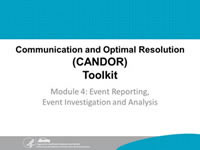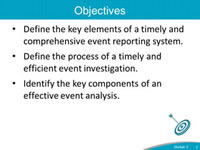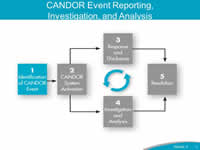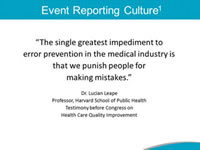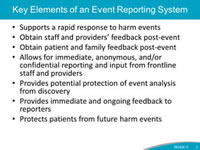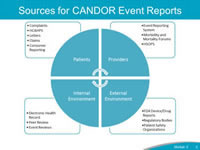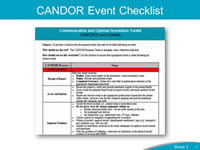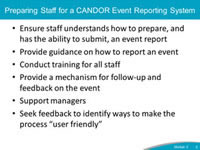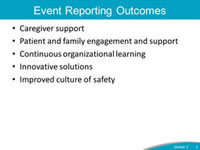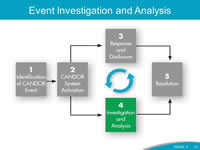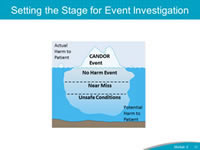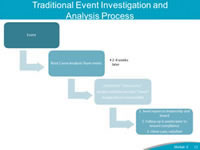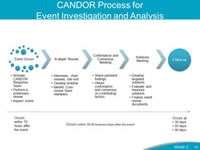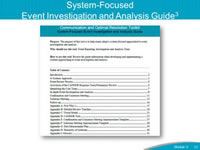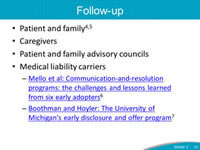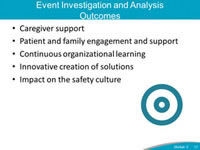Module 4: Event Reporting, Event Investigation and Analysis
AHRQ Communication and Optimal Resolution Toolkit
Facilitator Notes
|
Say: Module 4 of the CANDOR Toolkit covers the Event Reporting, Event Investigation, and Analysis component of the CANDOR process. |
Slide 1
|
|
Say: Objectives: At the end of this module, the learner will be able to:
|
Slide 2
|
|
Say: The identification and reporting of a CANDOR event initiates the CANDOR process and is a key foundational element of the CANDOR process. The goal for an organization implementing the CANDOR process is to increase the reporting of patient harm events. When a patient harm event occurs, rapid and timely reporting and comprehensive documentation of the details of the event are imperative. Ask:Ask the group to think about the organization's current event reporting process. Do they believe the organization is aware of all the patient harm events? Have they heard of events that should have been reported but were not reported? Say:Event reporting is the trigger for other CANDOR processes and is critical to establishing the CANDOR process within an organization. How an organization receives, manages, and encourages reporting is fundamental to the CANDOR process. This module includes information on the development of a reporting culture and the role of frontline staff and the organization in reporting CANDOR events, as well as information on Event Investigation and Analysis. |
Slide 3
|
|
Say: An organization's event reporting culture significantly impact this step in the CANDOR process. Dr. Lucian Leape stated during testimony before Congress on health care quality improvement that "The single greatest impediment to error prevention in the medical industry is 'that we punish people for making mistakes'." Ask:How would you describe the organization's culture relative to blame or responsibility for errors? How does the culture support or inhibit disclosing information to staff, patients, and families when a patient harm event occurs? Say:No one wants to hurt patients. Many health care systems reinforce a focus on individual behaviors designed to prevent mistakes and fail to recognize the impact of faulty systems, processes, and conditions that lead people to make mistakes. Approaches that focus on punishing individuals instead of changing systems provide strong incentives for people to report only those errors they cannot hide. A culture of blame does not encourage event reporting and can inhibit individual and system-wide performance improvement in patient safety. A Just Culture supports disclosure and learning from errors and encourages viewing every event as an opportunity to learn how to improve system performance relative to patient safety. The CANDOR Event Reporting process is supported by a culture of safety. |
Slide 4
|
|
Say: A timely, comprehensive, and supportive event reporting system can positively impact an organization's culture of safety. Key elements of an effective event reporting system include the following:
All of these elements support the foundation for a resilient reporting system. Ask:Which of these elements are part of your current event reporting system? |
Slide 5
|
|
Say: Event reporting should be a component of a larger patient safety system. This diagram demonstrates the various sources of information, other than event reports, that might provide information indicating that a CANDOR event has occurred, including:
All of these sources help create a cohesive environment for informing the organization as to whether a CANDOR event may have occurred. |
Slide 6
|
|
Say: The CANDOR Event Review Checklist helps organizations understand and document all the steps involved in event reporting, including;
This checklist also includes information on event investigation and analysis, which will be covered in more detail in the rest of this module. Many organizations implement the best practice of creating a hotline for staff to call when they feel a CANDOR event has occurred or is occurring. This hotline should be available 24 hours a day, 7 days a week, and staffed by the CANDOR Response Team member who understands the organization's CANDOR process and how to activate the CANDOR system within 30 minutes of receiving the event notification. Other methods of reporting CANDOR events may include in-person reporting. After initial reporting of the event, the CANDOR Response Team responds to the location of the event and uses the Event Review Checklist to begin the process. Within 60 minutes after a CANDOR event has been identified, an initial disclosure conversation should take place between a designated communicator and the patient and/or family. See Module 5 to learn more about the Response and Disclosure component of the CANDOR process. |
Slide 7
|
|
Say: Every organization should prepare all staff to successfully comply with a CANDOR Event Reporting System. Strategies to prepare staff include:
A resilient, sustainable reporting system provides training to all new hires and periodic updates to existing staff. The system should also include a process for followup and feedback to staff who report events to help staff feel connected not only to the problem, but also the solutions. Risk Management personnel should ensure all parts of the organization are using the event reporting system and reach out to areas that might need additional training and support. Risk Management can also provide ongoing support to managers on the unit(s) where the event occurred. A key component of a successful reporting system includes a mechanism for user feedback that continuously informs leaders of opportunities for improvement in the reporting process. |
Slide 8
|
|
Say: The desired outcomes of the CANDOR Event Reporting process include:
In the remainder of this module, we will discuss Event Investigation and Analysis activities. The way in which Event Investigation and Analysis is managed by teams can significantly impact frontline staff's perception about the safety culture of the organization. |
Slide 9
|
|
Say: The fourth component of the CANDOR process is Event Investigation and Analysis. Event investigation and analysis needs to be timely, efficient, and comprehensive and should include a systems review analysis.Within the first 72 hours of a CANDOR event, the following actions should occur:
Within 30-45 business days after the event, the investigation should allow for the determination of causal factors and appropriateness of standard of care. The sole objective of the Event Investigation and Analysis of an adverse event or near miss is to prevent future adverse events. This activity should not be used to apportion blame or liability. |
Slide 10
|
|
Say: One of the hallmarks of the CANDOR process is the focus on a systems approach to Event Investigation and Analysis. The rationale for a systems approach to Event Investigation and Analysis is that managing individual performance alone does not ensure that a harm event won't happen again.Human errors are abundant and inevitably repeated when system processes are not corrected or adjusted to prevent similar harm events from happening in the future. By focusing on system processes and factors that facilitated the event, adjustments can be made to minimize human error, resulting in fewer opportunities to produce a similar harm event again. A systems approach includes, as part of the event investigation, an analysis of how the system failed rather than focusing on individual blame. |
Slide 11
|
|
Say: Promoting a culture that is fair and just is a key goal of the CANDOR process. David Marx's Just Culture model refers to a system of "shared accountability" in which health care institutions are accountable for the practices they have designed and for sustaining the safe choices they have made regarding patients, visitors, and staff. Staff, in turn, are accountable for the quality of the choices they make to ensure patients receive high-quality, safe care. The CANDOR process recognizes the need to balance system and individual accountability to create an environment that is non-punitive and non-threatening and promotes open reporting of harm events. To strengthen system accountability, we want to learn what happened, why it happened, what normally happens, and what applicable procedure(s) are required. Only then can we learn why errors were truly made, and how we can implement policy, process, and improvement mechanisms to prevent the same errors from happening again. As discussed in Module 2 of the CANDOR Toolkit, individual staff must also hold themselves accountable by recognizing when they are engaging in at-risk behavior and how their behavior might cause unjustifiable harm to patients. More importantly, staff must hold themselves and others accountable for making appropriate behavioral choices. Managing behavioral choices should be a responsibility of the individual and the organization. More information on Just Culture can be found in the Apply CUSP module of the AHRQ CUSP Toolkit. |
Slide 12
|
|
Say: This diagram depicts the traditional Event Investigation and Analysis process in many organizations today. Generally speaking, about 2-4 weeks after an event occurs, a Root Cause Analysis team meets to determine the "root causes" for the event and assign a solution to each cause and a person responsible for implementing solutions to the root causes. Eventually, the team sends a report to leadership and the board, conducts followup 6 weeks later to ensure compliance with the solutions, and closes the investigation. Potential gaps in this process include:
The next slide demonstrates how this process can be improved with the implementation of the CANDOR Event Investigation and Analysis elements. |
Slide 13
|
|
Say: The CANDOR Process for Event Investigation and Analysis helps organizations to implement a process that will allow for an immediate response to the event by establishing a CANDOR Response Team with a primary reviewer and establishes an Event Review Core Team for the investigation. The Event Review Core team includes the primary reviewer, an executive leader, and administrative support. The CANDOR Response Team is responsible for conducting interviews of those individuals involved in the event, and supporting the patient, family, and caregivers at the time of the event. As the Event Investigation and Analysis continues, the Event Review Core Team institutes a process for a consensus and confirmation meeting and establishes a solutions meeting focused on systems-based solutions. |
Slide 14
|
|
Say: The System-Focused Event Investigation and Analysis Guide is part of this module and provides detailed resources and information to help an organization understand the specific steps to implementing a systems-based approach to Event Investigation and Analysis. This guide can be used to conduct an in-depth review of an event, manage a confirmation and consensus meeting, and conduct a solutions meeting. |
Slide 15
|
|
Say: To complete the Event Investigation and Analysis component of the CANDOR process, it is important to inform the patient, family, and the involved caregivers of the investigation and analysis results.Resources available to help your organization engage patients and families include:
Once the Event Investigation and Analysis is complete, it is important to provide these results to the liability carriers as well. Part of the CANDOR process implementation involves establishing open lines of communication with the organization's and the physician's liability carriers to ensure that all parties are aware of the results and how to move effectively to the Resolution component of the CANDOR process. Resources to help your organization engage medical liability carriers include:
|
Slide 16
|
|
Say: The desired outcomes of the CANDOR Event Investigation and Analysis process include:
In the next module, we will discuss the Response and Disclosure component of the CANDOR Process. |
Slide 17
|
|
|
Slide 18
|




